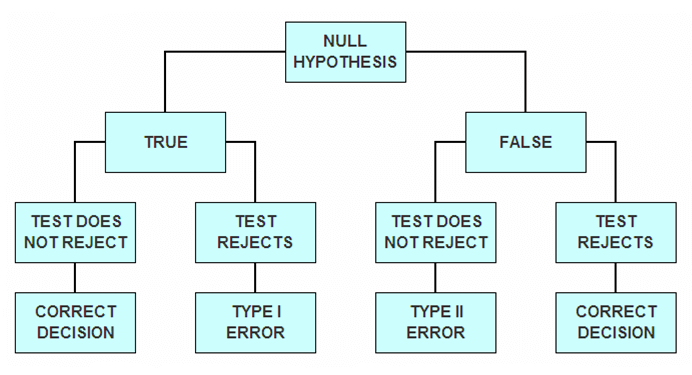In a test of hypothesis, a Type I error is committed when the null hypothesis is rejected despite being true.
Type I errors are also called errors of the first kind.
When conducting a test of hypothesis, we decide whether to reject the null hypothesis or not to reject it.
Usually, the decision is taken based on the value of a test statistic:
if the test statistic falls within a pre-specified critical region, then the null is rejected;
otherwise, it is not rejected.
In doing so, we can incur in the following error: reject the null hypothesis when the null hypothesis is indeed true.
Errors of this kind are called Type I errors, as opposed to Type II errors, which occur when the null hypothesis is not rejected despite being wrong.
This can be summarized in the following diagram.

As we have already explained, in a test of hypothesis we look at the value taken by a test statistic, and based on this value we decide whether or not tho reject the null hypothesis.
The value of the test statistic depends on the data used to perform the test, which is random. Therefore, before observing the data, the test statistic can be seen as a random variable.
The probability of committing a Type I error is equal to the probability that the test statistic will fall within the critical region. It is calculated under the assumption that the null hypothesis is true.
This probability (or an upper bound to it) is called size of the test, or level of significance of the test.
Suppose that we observe a sample of draws
![]() from a normal
distribution.
from a normal
distribution.
The mean of the distribution
is unknown and its variance
is known.
We want to test the null hypothesis that the mean of the distribution is equal
to
zero:![]()
As explained in the lecture on the size of a test, we can use the z-statistic as a test statistic.
First, we compute the sample
mean![[eq3]](/images/Type-I-error__5.png)
Then, we compute the
z-statistic:![[eq4]](/images/Type-I-error__6.png) where
we set
where
we set
![]() ,
according to our null hypothesis.
,
according to our null hypothesis.
We compare the value taken by the test statistic to a
critical value
.
In particular, we take a decision based on the following rule:
if
![]() ,
then we do not reject the null hypothesis;
,
then we do not reject the null hypothesis;
if
![]() ,
then we reject the null hypothesis.
,
then we reject the null hypothesis.
Suppose that the true mean
is indeed equal to zero.
If
![]() ,
then the outcome of the test is a rejection of the null hypothesis
,
then the outcome of the test is a rejection of the null hypothesis
![]() .
.
This is a Type I error! We are rejecting the null when it is in fact true.
In this example, the probability of committing Type I errors is
![]()
Note that the probability needs to be calculated under the assumption that
(i.e., under the assumption that the null hypothesis holds).
A formula for this probability is derived in the lecture entitled Hypothesis tests about the mean.
An example of how to apply the formula can be found in the lecture on the size of a test.
There is usually a trade-off between the probability of committing Type I errors and the probability of committing Type II errors: a test that is less likely to reject a correct hypothesis is usually also more likely not to reject an incorrect one.
Type I errors are more thoroughly discussed in the lecture entitled Hypothesis testing.
Previous entry: Transformation theorem
Next entry: Type II error
Please cite as:
Taboga, Marco (2021). "Type I error", Lectures on probability theory and mathematical statistics. Kindle Direct Publishing. Online appendix. https://www.statlect.com/glossary/Type-I-error.
Most of the learning materials found on this website are now available in a traditional textbook format.